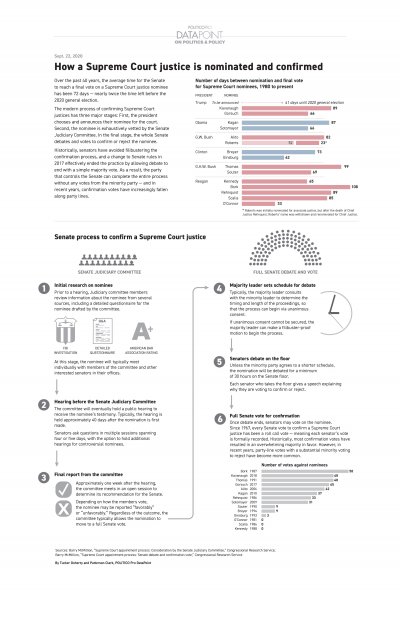Over the past 40 years, the average time for the Senate to reach a final vote on a Supreme Court justice nominee has been 72 days — nearly twice the time left before the 2020 general election.
The modern process of confirming Supreme Court justices has three major stages: First, the president chooses and announces their nominee for the court. Second, the nominee is exhaustively vetted by the Senate Judiciary Committee. In the final stage, the whole Senate debates and votes to confirm or reject the nominee.
Historically, senators have avoided filibustering the confirmation process, and a change to Senate rules in 2017 effectively ended the practice by allowing debate to end with a simple majority vote. As a result, the party that controls the Senate can complete the entire process without any votes from the minority party — and in recent years, confirmation votes have increasingly fallen along party lines.
Here are the steps in the Senate process to confirm a Supreme Court Justice
1. Initial research on nominee
Prior to a hearing, Judiciary committee members review information about the nominee from several sources, including a detailed questionnaire for the nominee drafted by the committee.
At this stage, the nominee will typically meet individually with members of the committee and other interested senators in their offices.
2. Hearing before the Senate Judiciary Committee
The committee will eventually hold a public hearing to receive the nominee’s testimony. Typically, the hearing is held approximately 40 days after the nomination is first made.
Senators ask questions in multiple sessions spanning four or five days, with the option to hold additional hearings for controversial nominees.
3. Final report from the committee
Approximately one week after the hearing, the committee meets in an open session to determine its recommendation for the Senate.
Depending on how the members vote, the nominee may be reported “favorably” or “unfavorably.” Regardless of the outcome, the committee typically allows the nomination to move to a full Senate vote.
4. Majority Leader sets schedule for debate
Typically the Majority Leader consults with the minority leader to determine the timing and length of the proceedings, so that the process can begin via unanimous consent.
If unanimous consent cannot be secured, the majority leader can make a filibuster-proof motion to begin the process.
5. Senators debate on the floor
Unless the minority party agrees to a shorter schedule, the nomination will be debated for a minimum of 30 hours on the Senate floor.
Each senator who takes the floor gives a speech explaining why they are voting to confirm or reject.
6. Full Senate vote for confirmation
Once debate ends, senators may vote on the nominee. Since 1967, every Senate vote to confirm a Supreme Court justice has been a roll call vote — meaning each senator’s vote is formally recorded. Historically, most confirmation votes have resulted in an overwhelming majority in favor. However, in recent years, party-line votes with a substantial minority voting to reject have become more common.
Download the full DataPoint >>

This post is excerpted from a DataPoint infographic that was initially made available to POLITICO Pro Premium subscribers on September 22, 2020.
If you would like to learn more about POLITICO Pro Premium, you can visit this page.

